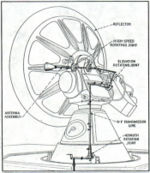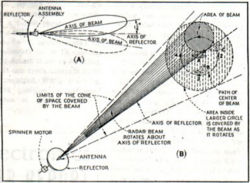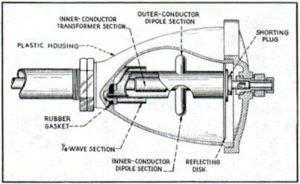VERLORT Radar
| Revision as of 07:22, 8 May 2007 (edit) Paul (Talk | contribs) ← Previous diff |
Revision as of 07:27, 8 May 2007 (edit) Paul (Talk | contribs) Next diff → |
||
| Line 8: | Line 8: | ||
| Even more intriguing were the target acquisition techniques. | Even more intriguing were the target acquisition techniques. | ||
| - | For targets where only crude position information was available, a helical scan was used to acquire. The dish was swung in a circle at 6 rpm along the expected path with the reflector tilted to and fro about 4 deg per dish revolution to create a helical spiral about 20 deg wide along the expected track path - see 'Helical scan mechanism' diagram on right. | + | For targets where only crude position information was available, a helical scan was used to acquire. The dish was swung in a circle at 6 rpm along the expected path with the reflector tilted to and fro about 4 deg per dish revolution to create a helical spiral about 20° wide along the expected track path - see 'Helical scan mechanism' diagram on right. |
| - | Where there was more certainty about the target path, a nutating scan mode was used where the slightly offset dipole feed was rotated rapidly to produce off-axis radiation to increase the effective beam width from 2.5 deg to about 5.5 deg. The nutation was switched off when the target was acquired. See ‘conical scan beam’ diagram below left and ‘nutating antenna dipole feed’ below right. | + | Where there was more certainty about the target path, a nutating scan mode was used where the slightly offset dipole feed was rotated rapidly to produce off-axis radiation to increase the effective beam width from 2.5° to about 5.5°. The nutation was switched off when the target was acquired. See ‘conical scan beam’ diagram below left and ‘nutating antenna dipole feed’ below right. |
| [[Image:Conical beam.jpg|left|thumbnail|250px|A conical scan beam:<BR> ''Image – ‘Electronics’; Fig 1, Nov ’45, p.104'']] | [[Image:Conical beam.jpg|left|thumbnail|250px|A conical scan beam:<BR> ''Image – ‘Electronics’; Fig 1, Nov ’45, p.104'']] | ||
| [[Image:offset dipole.jpg|right|thumbnail|300px|Nutating antenna dipole feed:<BR>''Image – ‘Electronics’; Fig 5, Dec ’45, p.107'']] | [[Image:offset dipole.jpg|right|thumbnail|300px|Nutating antenna dipole feed:<BR>''Image – ‘Electronics’; Fig 5, Dec ’45, p.107'']] | ||
| - | + | <BR><BR><BR><BR><BR><BR><BR><BR><BR> | |
| For a detailed technical description of the SCR-584 radar published in the November & December 1945 issues of ‘Electronics’ magazine refer to http://www.hamhud.net/darts/scr584.html. | For a detailed technical description of the SCR-584 radar published in the November & December 1945 issues of ‘Electronics’ magazine refer to http://www.hamhud.net/darts/scr584.html. | ||
Revision as of 07:27, 8 May 2007
Some technical descriptions
The SCR family of radars, developed at the MIT laboratories, was remarkable for the innovative MIT solutions to radar operations now met in modern radars using electronic methods.
The Verlort Plan Position Indicator (PPI) was driven by a mechanical computer once target acquisition occurred with the radar operator needing to keep a ‘hairline’ indicator manually centred on the target’s echo to maintain track.
Even more intriguing were the target acquisition techniques.
For targets where only crude position information was available, a helical scan was used to acquire. The dish was swung in a circle at 6 rpm along the expected path with the reflector tilted to and fro about 4 deg per dish revolution to create a helical spiral about 20° wide along the expected track path - see 'Helical scan mechanism' diagram on right.
Where there was more certainty about the target path, a nutating scan mode was used where the slightly offset dipole feed was rotated rapidly to produce off-axis radiation to increase the effective beam width from 2.5° to about 5.5°. The nutation was switched off when the target was acquired. See ‘conical scan beam’ diagram below left and ‘nutating antenna dipole feed’ below right.
For a detailed technical description of the SCR-584 radar published in the November & December 1945 issues of ‘Electronics’ magazine refer to http://www.hamhud.net/darts/scr584.html.



